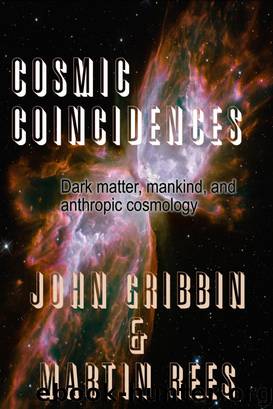Cosmic Coincidences by John Gribbin

Author:John Gribbin
Language: eng
Format: epub
Tags: string theory, big bang, cosmology, dark matter, einstein, quantum mechanics, black holes
Publisher: ReAnimus Press
More Answers than Questions
The difficulty is not finding a candidate for the dark stuff in the haloes of galaxies but choosing among the many good candidates we have. The halo stuff could be baryons, either in the form of large black holes formed after the Big Bang or of Jupiters and brown dwarfs formed in cooling flows as the Galaxy itself formed. Or it could be nonbaryonic cold dark matter, anything from axions to primordial black holes. As far as our Galaxy alone goes, the odds on each of the three main options must be roughly equal. However, if the Universe is indeed flat, the standard Big Bang requires that there must be nonbaryonic stuff about; moreover, massive haloes arise naturally in computer simulations of the CDM cosmology. So, taking a broader perspective, we would expect at least part of the mass of the halo to be nonbaryonic cold dark matter. And within that framework, the way gas would stream into the forming galaxy from outside is so reminiscent of cooling flows seen today that it would be astonishing if low-mass stars were not formed in the process.
If we were forced to come down off the fence, then, we would suggest that the halo of our Galaxy is probably dominated by nonbaryonic cold dark matter, with the Lightest Supersymmetric Partner not only the best candidate but the one most likely to be detected on Earth (and inside the Sun!). Within that CDM background, however, there should also be a significant amount of baryonic material, in the form of low-mass stars or large, planetlike objects. Beyond the dark halo, if the Universe really is flat, the cold dark particles must dominate. In a sense, the halo stuff marks a transition zone between the region where CDM dominates and the region of bright stars where baryons come into their own. And the ultimate expression of baryonic matter lies at the hearts of galaxies, where huge masses are concentrated into small volumes, producing black holes in an altogether different league from anything we have considered so far.
Download
This site does not store any files on its server. We only index and link to content provided by other sites. Please contact the content providers to delete copyright contents if any and email us, we'll remove relevant links or contents immediately.
| Aeronautics & Astronautics | Astronomy |
| Astrophysics & Space Science | Comets, Meteors & Asteroids |
| Cosmology | Mars |
| Solar System | Star-Gazing |
| Telescopes | UFOs |
Tools of Titans by Timothy Ferriss(8306)
Turbulence by E. J. Noyes(7981)
Secrets of Antigravity Propulsion: Tesla, UFOs, and Classified Aerospace Technology by Ph.D. Paul A. Laviolette(5335)
Astrophysics for People in a Hurry by Neil DeGrasse Tyson(5152)
Room 212 by Kate Stewart(5073)
Design of Trajectory Optimization Approach for Space Maneuver Vehicle Skip Entry Problems by Runqi Chai & Al Savvaris & Antonios Tsourdos & Senchun Chai(5039)
Pale Blue Dot by Carl Sagan(4960)
The David Icke Guide to the Global Conspiracy (and how to end it) by David Icke(4658)
A Journey Through Divination and Astronomy by Publishing Pottermore(4364)
Goodbye Paradise(3763)
Apollo 8 by Jeffrey Kluger(3671)
COSMOS by Carl Sagan(3590)
The Five People You Meet in Heaven by Mitch Albom(3521)
Losing the Nobel Prize by Brian Keating(3519)
How to Read Water: Clues and Patterns from Puddles to the Sea (Natural Navigation) by Tristan Gooley(3434)
Brief Answers to the Big Questions by Stephen Hawking(3394)
How to Read Nature by Tristan Gooley(3294)
The Order of Time by Carlo Rovelli(3163)
A Brief History of Time by Stephen Hawking(2994)
